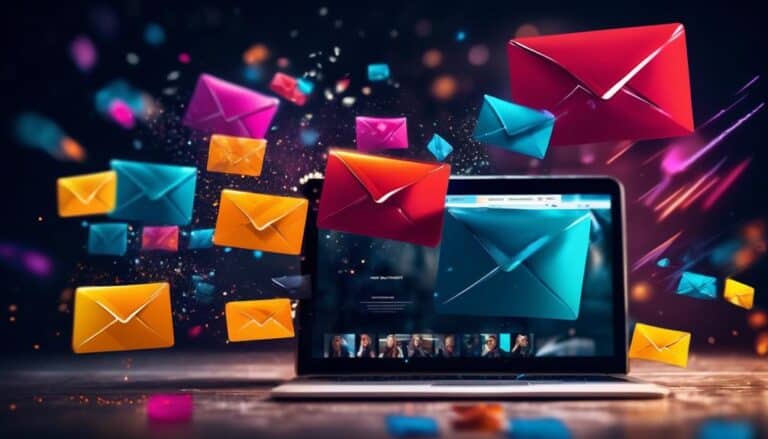Act Fast: Transform Your Email Marketing With These Segmentation Secrets
Did you know that email marketing campaigns with segmented lists can achieve a 760% increase in revenue? If you're looking to take your email marketing to the next level, segmentation is the key.
But what exactly is segmentation and how can it transform your email marketing efforts? In this discussion, we will explore the secrets behind effective email segmentation and how it can help you reach the right audience at the right time.
Get ready to discover the strategies and tactics that will revolutionize your email campaigns and drive impressive results. Are you ready to unlock the secrets to successful email segmentation?
Key Takeaways
- Email segmentation can lead to a significant increase in revenue for email marketing campaigns.
- Targeted email campaigns with personalized content can improve open rates and convert readers into customers.
- Personalization and tailored messaging based on customer preferences and behaviors can enhance the overall customer experience.
- Analyzing data from email campaigns can provide insights to optimize future campaigns for higher conversion rates.
The Power of Email Segmentation

Discover the immense power of email segmentation and unlock its potential to skyrocket your email marketing success. With the ever-increasing competition in the digital landscape, it's crucial to adopt innovative strategies that truly resonate with your target audience.
Email segmentation is the key to achieving this level of personalization and relevance.
By dividing your email list into specific customer groups, you can tailor your messaging to meet the unique needs and preferences of each segment. Gone are the days of sending generic mass emails that fail to engage your subscribers.
With email segmentation, you can target different customer groups based on factors such as demographics, purchase history, or engagement level. This level of precision allows you to deliver content that's highly relevant and valuable to each segment.
Not only does email segmentation improve the effectiveness of your campaigns, but it also enhances the overall customer experience. By receiving content that's tailored to their specific interests and needs, subscribers are more likely to engage with your emails, leading to higher open rates, click-through rates, and ultimately, conversions.
Benefits of Targeted Email Campaigns
Are you struggling to get your emails opened and read? Targeted email campaigns can be the solution you've been looking for.
By segmenting your email list and tailoring your messages to specific groups of people, you can see a significant increase in open rates. This means more eyes on your content and a higher chance of converting those readers into customers.
Plus, by personalizing the customer experience, you can foster a stronger connection and build trust with your audience.
Increased Open Rates
Increase your email open rates and maximize the effectiveness of your targeted email campaigns with these proven strategies. By implementing these techniques, you can significantly boost your open rates and engage with your audience more effectively. Take a look at the table below to see three key strategies that can help you achieve higher open rates:
| Strategy | Description | Benefits |
|---|---|---|
| Personalization | Tailoring your emails to individual recipients based on their preferences and behaviors. | Increased click-through rates and higher engagement. |
| A/B Testing | Testing different subject lines, email designs, and content variations to identify what resonates best with your audience. | Improved open rates and better understanding of what drives engagement. |
| Timing and Frequency | Sending emails at the right time and finding the optimal frequency to avoid overwhelming your subscribers. | Higher open rates and reduced unsubscribe rates. |
Higher Conversion Rates
To maximize your email marketing efforts and drive higher conversion rates, it's crucial to tailor your messages to individual recipients based on their preferences and behaviors. Effective targeting is the key to achieving these higher conversion rates.
By segmenting your email list and creating personalized campaigns, you can deliver relevant content that resonates with your audience. When you send targeted emails, you show your recipients that you understand their needs and interests. This personalized approach increases the likelihood of conversion because it makes your audience feel valued and understood.
Additionally, by analyzing the data from your email campaigns, you can gain insights into what strategies are working and optimize your future campaigns for even higher conversion rates.
Personalized Customer Experience
By tailoring your email campaigns to meet the unique needs and preferences of your customers, you can create a personalized customer experience that fosters strong connections and drives higher engagement. Personalization benefits go beyond just addressing your customers by their names; it's about understanding their interests, behaviors, and preferences to deliver relevant content that resonates with them. This level of personalization can significantly improve customer engagement and drive better results for your email marketing campaigns. To help you understand the impact of personalized customer experiences, take a look at the table below:
| Personalization Benefits | Customer Engagement Strategies |
|---|---|
| Increases open rates | Segment your audience |
| Boosts click-through rates | Create dynamic content |
| Reduces unsubscribe rates | Use personalized subject lines |
| Improves conversion rates | Implement triggered emails |
How to Identify Segmentation Criteria
Are you struggling to identify the right criteria for segmenting your email marketing campaigns? Don't worry, we've got you covered!
When it comes to demographic segmentation, you can consider options such as age, gender, location, and income level.
For behavioral segmentation, think about the actions and interactions your audience has with your brand.
Lastly, psychographic segmentation focuses on understanding the attitudes, values, and interests of your subscribers.
Demographic Segmentation Options
Discover the key demographic segmentation options that will allow you to identify the most effective criteria for targeting your email marketing campaigns.
When it comes to geographical segmentation options, you can break down your audience based on location, such as country, state, or city. This can help you tailor your content to specific regional preferences and interests.
Additionally, industry-specific segmentation strategies can be incredibly powerful. By dividing your audience based on the industry they work in or the type of business they own, you can deliver highly relevant and targeted messages that resonate with their specific needs and challenges.
This level of personalization won't only improve engagement but also increase the likelihood of conversions.
Behavioral Segmentation Techniques
To effectively identify segmentation criteria for behavioral segmentation techniques, you need to understand your audience's unique preferences and actions. By analyzing their behaviors, you can tailor your email marketing campaigns to optimize engagement and drive conversions.
Here are three behavioral targeting strategies to consider:
- Purchase history: Analyze what products or services your audience has previously bought to personalize future recommendations and offers.
- Website browsing behavior: Track the pages your audience visits, the time spent on each page, and the actions they take to understand their interests and tailor your content accordingly.
- Email engagement: Monitor open rates, click-through rates, and conversion rates to identify your most engaged subscribers and create targeted campaigns for them.
Psychographic Segmentation Strategies
By understanding your audience's unique preferences and actions through behavioral segmentation techniques, you can now delve into psychographic segmentation strategies to further personalize your email marketing campaigns. Psychographic targeting allows you to target customer preferences based on their psychological and emotional characteristics. This deeper level of understanding enables you to create more personalized and relevant content that resonates with your audience on a deeper level. To effectively implement psychographic segmentation, consider the following criteria:
| Psychographic Segment | Description | Example |
|---|---|---|
| Lifestyle | Targeting customers based on their interests, values, and activities. | Fitness enthusiasts, environmental activists |
| Personality | Targeting customers based on their personality traits and characteristics. | Introverts, extroverts |
| Values | Targeting customers based on their beliefs and principles. | Social justice advocates, animal rights activists |
Segmenting Based on Demographic Data
Improve the effectiveness of your email marketing campaigns by utilizing demographic data segmentation to target your audience more effectively. By segmenting your email list based on demographic data, you can tailor your messages to the specific needs and preferences of each group.
Here are three ways demographic data segmentation can revolutionize your email marketing strategy:
- Customer preferences: By analyzing demographic data such as age, gender, and occupation, you can gain insights into your customers' preferences and interests. This allows you to create targeted email content that resonates with each segment, increasing engagement and conversion rates.
- Geographic targeting: Demographic data can provide valuable information about your customers' locations. By segmenting your email list based on geographic data, you can deliver localized content, promotions, and offers that are relevant to each specific region. This personalized approach enhances the customer experience and drives higher customer loyalty.
- Personalized recommendations: Demographic data can reveal important details about your customers' lifestyles, hobbies, and interests. By leveraging this information, you can send personalized recommendations and product suggestions that align with each segment's preferences. This not only boosts customer satisfaction but also increases the likelihood of repeat purchases.
Incorporating demographic data segmentation into your email marketing strategy allows you to deliver more targeted, personalized, and relevant content to your audience. By understanding your customers' preferences and tailoring your messages accordingly, you can drive higher engagement, conversion rates, and ultimately, business growth.
Stay ahead of the competition by harnessing the power of demographic data segmentation in your email marketing campaigns.
Using Customer Behavior for Segmentation

Discover the power of customer behavior segmentation and unlock new opportunities for targeted and personalized email marketing campaigns. By analyzing your customers' behavior, you can gain valuable insights into their preferences and interests. This allows you to tailor your email content to their specific needs, increasing customer engagement and ultimately optimizing your email campaigns for better results.
To effectively use customer behavior for segmentation, consider the following:
| Customer Behavior | Segmentation Strategy | Benefits |
|---|---|---|
| Purchase History | Recommend products based on past purchases | Increase customer loyalty and drive repeat purchases |
| Website Activity | Send targeted emails based on pages visited or items viewed | Improve conversion rates and drive sales |
| Email Engagement | Segment based on open and click-through rates | Increase email deliverability and engagement |
By segmenting your email list using customer behavior, you can send more relevant and personalized content, leading to higher open rates, click-through rates, and ultimately, better ROI. Additionally, you can use this data to identify trends and patterns, enabling you to optimize your email campaigns for maximum effectiveness.
Take advantage of the power of customer behavior segmentation to supercharge your email marketing efforts. By understanding your customers' preferences and tailoring your content accordingly, you can drive higher engagement and achieve better results. Embrace innovation and unlock the potential of personalized email marketing today.
Leveraging Purchase History for Personalization
Maximize the impact of your email marketing campaigns by harnessing the power of your customers' purchase history. Leveraging their past purchases allows you to create personalized and targeted email campaigns that drive results.
Here are three ways you can utilize purchase history for personalization:
- Tailor product recommendations: By analyzing your customers' purchase history, you can determine their preferences and recommend products that align with their interests. This level of personalization enhances the customer experience and increases the likelihood of conversion.
- Segment based on purchase frequency: Understanding how often your customers make purchases can help you create targeted email campaigns. For example, you can send regular customers exclusive offers or rewards to encourage repeat purchases, while engaging with infrequent buyers by highlighting new products or limited-time promotions.
- Upsell and cross-sell opportunities: Leverage purchase history to identify upselling and cross-selling opportunities. Send targeted emails suggesting complementary products or upgrades to increase the average order value and maximize revenue.
Implementing Dynamic Content in Emails

By harnessing the power of dynamic content, you can take your personalized email marketing campaigns to the next level, creating engaging and tailored experiences for your customers. Gone are the days of generic, one-size-fits-all emails. With dynamic email templates, you have the ability to deliver content that's personalized and relevant to each individual recipient.
Dynamic content allows you to showcase different products, promotions, or recommendations based on the unique preferences and behaviors of your customers. By using personalization techniques, such as using their name, location, or previous purchase history, you can create a sense of exclusivity and make your customers feel valued.
Imagine receiving an email that not only addresses you by name but also features products or offers that align perfectly with your interests and needs. This level of customization can significantly increase engagement and conversions. By leveraging dynamic content, you can captivate your audience and drive them to take action.
Dynamic content isn't just about personalization; it's about delivering the right message to the right person at the right time. By segmenting your audience and tailoring your content accordingly, you can ensure that your emails resonate with your customers and provide them with a seamless and enjoyable experience.
Incorporating dynamic content in your email marketing strategy is a game-changer. It allows you to create highly targeted and personalized campaigns that will set you apart from your competitors. So, don't miss out on this opportunity to innovate and elevate your email marketing efforts. Start implementing dynamic content today and witness the impact it can have on your business.
A/B Testing Segmented Campaigns
To optimize your email marketing campaigns, you need to conduct A/B testing on your segmented campaigns. A/B testing allows you to compare different versions of your email to see which one performs better. By testing different variables, you can gain valuable insights into what resonates with your audience and improve your campaign effectiveness.
Here are three best practices for A/B testing segmented campaigns:
- Test one variable at a time: To accurately measure the impact of a specific change, focus on testing one variable at a time. This could be the subject line, call-to-action, or even the layout of your email.
- Split your audience evenly: Ensure that your test groups are evenly divided to avoid any bias in the results. This will help you accurately measure the effectiveness of each variation.
- Set clear goals and metrics: Before conducting your A/B test, define your goals and the metrics you'll use to measure success. Whether it's click-through rates, conversion rates, or revenue generated, having clear objectives will guide your testing process.
Measuring Success and Fine-Tuning Segmentation

Now that you have conducted A/B testing on your segmented campaigns, it's time to measure their success and fine-tune your segmentation strategy for even better results. Measuring campaign effectiveness is crucial to understand what works and what doesn't, allowing you to optimize your segmentation strategy and drive better engagement with your audience.
To effectively measure your campaign's success, you need to focus on key metrics that indicate the impact of your segmentation efforts. These metrics include open rates, click-through rates, conversion rates, and revenue generated. By analyzing these metrics, you can identify which segments are performing well and which ones need improvement.
To help you better understand the impact of segmentation on your email marketing campaigns, here is a table showcasing the results of two different segmented campaigns:
| Segment | Open Rate | Click-Through Rate | Conversion Rate |
|---|---|---|---|
| Segment A | 20% | 5% | 2% |
| Segment B | 35% | 8% | 4% |
From the table above, it is clear that Segment B outperforms Segment A in all key metrics. This insight allows you to focus your resources on optimizing Segment B and improving the performance of Segment A.
Frequently Asked Questions
How Can I Automate the Process of Email Segmentation?
Want to streamline your email targeting? Automating segmentation processes is the key. By using advanced tools and data analysis, you can effortlessly divide your audience into specific groups, maximizing the impact of your marketing campaigns. Act fast and transform your email marketing today!
What Are Some Common Challenges Faced When Implementing Email Segmentation?
Challenges arise when implementing email segmentation, but don't fret! With the right strategies, you can tackle them head-on. By targeting specific audiences, personalizing content, and analyzing data, you'll revolutionize your email marketing game. Act fast and transform your approach today!
Can I Use Email Segmentation for B2B Email Marketing?
Yes, you can use email segmentation for B2B email marketing. By implementing effective B2B segmentation strategies, you can experience the benefits of email segmentation for B2B marketing, such as increased engagement and higher conversion rates. Act now and transform your email marketing!
How Often Should I Update My Segmentation Criteria?
You should update your segmentation criteria regularly to ensure effective targeting. By analyzing customer behavior, you can identify patterns and preferences, allowing you to create personalized and targeted campaigns. Measure success by tracking open rates, click-through rates, and conversions.
Are There Any Legal Considerations to Keep in Mind When Using Email Segmentation?
When it comes to email segmentation, it's important to consider the legal aspects. Privacy implications and ethical concerns should be top of mind. Act fast to ensure you're using segmentation techniques responsibly and within the law.
Conclusion
Act now and revolutionize your email marketing by implementing the secrets of segmentation. By targeting your audience based on their demographics, behavior, and purchase history, you can create personalized and engaging campaigns that will grab their attention.
Don't forget to incorporate dynamic content and A/B testing to ensure optimal results. Measure your success and fine-tune your segmentation strategy to continuously improve your marketing efforts.
Get started today and transform your email marketing into a powerhouse of success.








